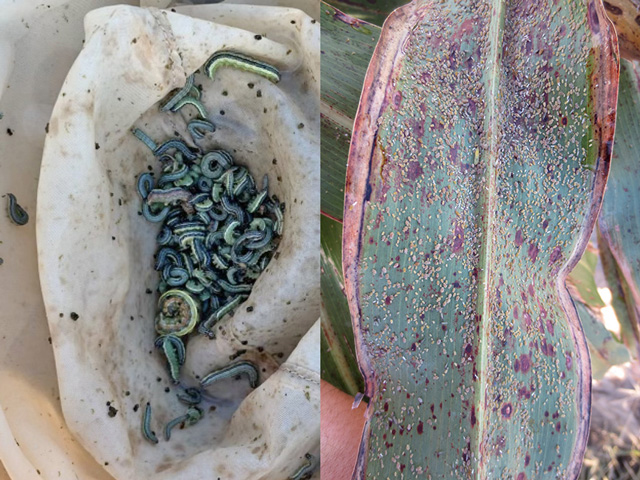Late-Season Insect Alert
Scout for Fall Armyworms, Sugarcane Aphids and Rootworms
ROCKVILLE, Md. (DTN) -- The summer growing season may be heading into its final stages, but some insects are still hard at work.
Fall armyworms are marching in unusually high numbers, threatening a host of crops, initially in southern states and now farther north. In the meantime, sugarcane aphids are picking up in sorghum fields in the Southern Plains and a big year for corn rootworms is still unfolding in the Corn Belt.
Here's a look at these pests, with reminders from Extension entomologists on how best to manage them.
FALL ARMYWORMS STILL MARCHING
Fall armyworm, infamous for its ability to "march" into fields and strip them bare, has lived up to its name this summer. Ravenous armies of this caterpillar have hit pastures, rice, sorghum and soybean fields in several Southern states such as Alabama, Mississippi and Arkansas, and they're not finished yet.
Most recently entomologists farther north in states such as Indiana, Kansas and Kentucky have been alerting corn, soybean, forage and turf growers to the threat.
"In Indiana, those with late-season crops, (e.g., double-crop soybean, forages, cover crops, alfalfa) should be inspecting for feeding damage," cautioned Purdue University entomologist Christian Krupke and IPM specialist John Obermeyer in an Aug. 6 newsletter. "This is very important for newly-seeded forages."
The key to control is early detection, the scientists said. "You have been warned, get them early!" they wrote. "When the worms are about an inch long, they can denude plants 'overnight' when they are 'marching.' [L]arger worms are very difficult to control."
P[L1] D[0x0] M[300x250] OOP[F] ADUNIT[] T[]
Insecticides such as pyrethroids may be compromised by growing resistance among fall armyworm populations, and they are also naturally less effective against larger caterpillars, explained University of Kentucky Extension entomologist Raul Villanueva in another university alert.
See more information on the extent of the infestations and resources on how to manage the fall armyworm from DTN here: https://www.dtnpf.com/….
See Krupke and Obermeyer's warning here: https://extension.entm.purdue.edu/… and Villanueva's article here: https://kentuckypestnews.wordpress.com/…
SUGARCANE APHIDS
Sugarcane aphids are spreading in sorghum, primarily in Oklahoma, Texas and Kansas. Infestations of these pests not only drain sorghum plants of needed moisture and energy, but they leave a sticky honeydew that can foster mold that hurts the plant and clogs combines.
Since the pest first began colonizing sorghum in 2013, crop scientists have made major headway in identifying naturally resistant varieties, but susceptible sorghum hybrids can still take a large yield hit from infestations.
"It is best practice to scout late-planted fields, as these are more susceptible to yield loss and aphids, and [provide] a bigger window for aphids to build to damaging levels later in the season," a group of Kansas State entomologists wrote in a recent agronomy update.
Thresholds for the sugarcane aphid vary not only by the stage of sorghum growth but also by region. See the growth stage thresholds here from Kansas State: https://eupdate.agronomy.ksu.edu/… and see more on regional differences for treatment recommendations from the Sorghum Checkoff here: https://www.sorghumcheckoff.com/….
ROOTWORM RAMP-UP
Western and northern corn rootworms have had a major resurgence in the Corn Belt this year, and entomologists are warning growers their scouting work is not over yet.
"We are rapidly coming to that time (early -- mid-August) when adult corn rootworms will start laying eggs in cornfields and they will do so for a three-week period of time," explained University of Wisconsin entomologist Bryan Jensen. "From a pest management standpoint, this is an important period to scout. Knowing field-specific populations can have a significant influence on management and help avoid costly mistakes."
Growers facing high populations this summer will have to decide for next year how best to manage the pest, populations of which have evolved resistance to Bt proteins on the market. Primary options include rotating traits, adding soil insecticide or switching to a non-host crop, such as soybeans. A new rootworm trait from Bayer that uses RNA-interference (RNAi) technology will also be available in 2022, branded SmartStax PRO.
Use the Handy Bt Trait table for help sorting out which rootworm traits are in your current corn hybrids: https://agrilife.org/….
A new website has been mobilized specifically to track this growing threat, as rootworm populations increase. Growers can view the map, which shows the numbers of adult beetles caught by yellow sticky traps across the corn-growing region, as far west as Kansas and Nebraska out to Virginia and Quebec. See it here: https://www.arcgis.com/….
See more on late-season rootworm scouting from Jensen here: https://ipcm.wisc.edu/….
Emily Unglesbee can be reached at Emily.unglesbee@dtn.com
Follow her on Twitter @Emily_Unglesbee
(c) Copyright 2021 DTN, LLC. All rights reserved.






